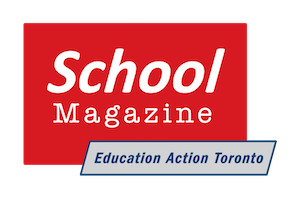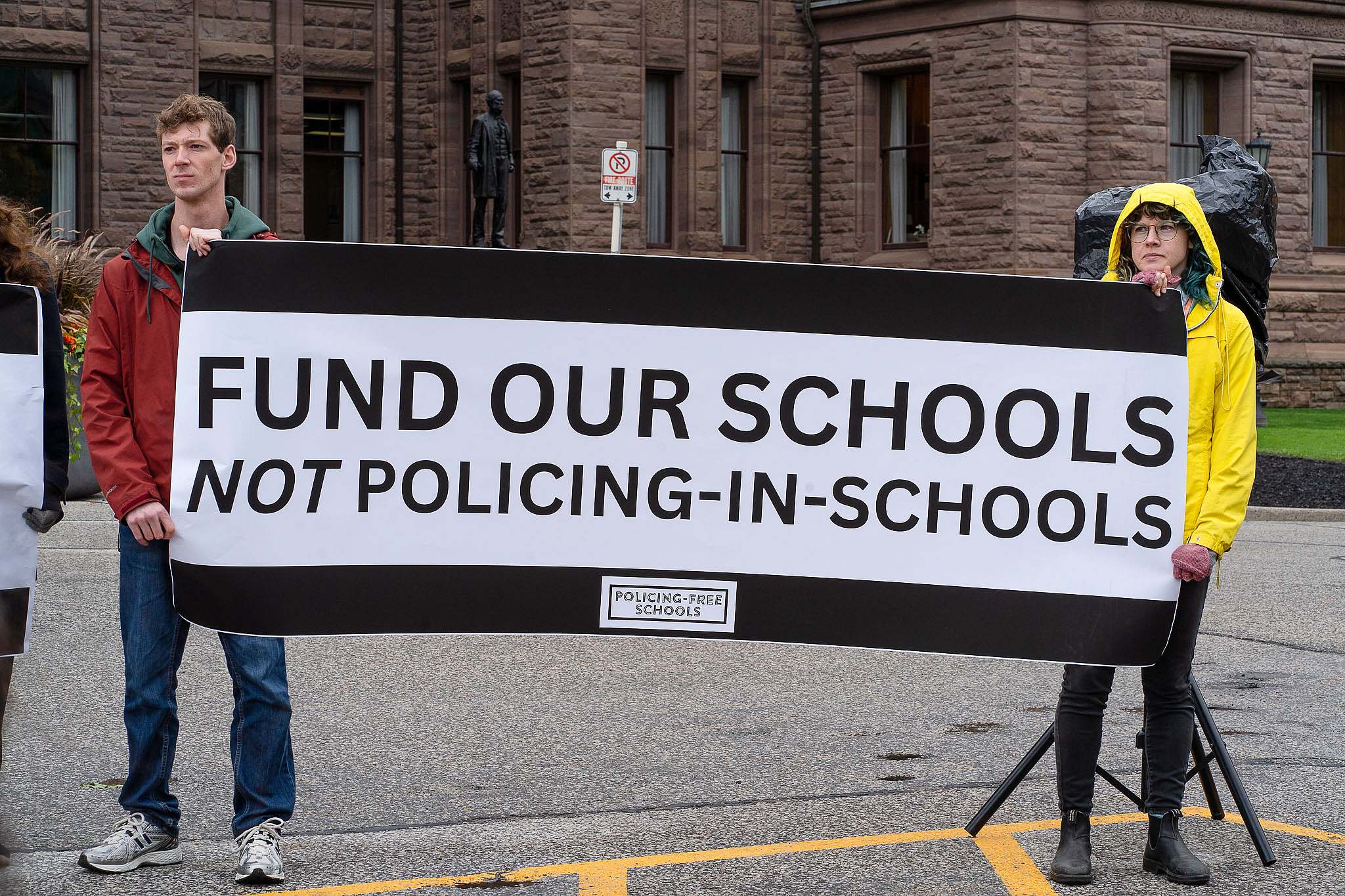Bill 33 and police in our schools
“There can be no keener revelation of a society’s soul than the way in which it treats its
children.” — Nelson Mandela
Introduction:
With Bill 33, Supporting Children and Students Act, Education Minister Paul Calandra seeks to undermine local democracy by making it easier to seize control of school boards as well as their properties through a proposed regulation change. He seeks to arrogate to his ministry, decisions about the names of schools. And, in a move that echoes the current authoritarianism of the United States, Calandra’s Bill 33 will place police in our schools. Here is the text of a speech about this part of the bill, delivered by Kathy-Ann Murray from Defence for Children International – Canada to the Policing-Free School Rally earlier this week.
We cannot build safe schools through fear and surveillance—we build safety through rights, care, and community.
Good morning. My name is Kathy-Ann Murray, and I am here today as a representative of Defence for Children International – Canada, (DCI) and as a graduate student in Criminology who studies the impact of systems on young people along with my peer Ashu Kito. But I am also here as someone who comes from a community that has lived the consequences of racial profiling, over-policing, and systemic injustice.
I have a younger brother who went to a school where police officers were present. Not because he was violent. Not because he was unsafe. But because society has been conditioned to view young Black boys as threats before they are seen as children. He was pulled aside more than once for “random questioning.” He was watched more closely, disciplined more harshly, and made to feel like he didn’t belong in a place that was supposed to be his second home.
This is not safety. This is surveillance. This is policing—not protection. And that is exactly what Bill 33 threatens to expand across Ontario.
In the U.S. schools with police are 38% more likely to suspend students and three times more likely to refer children to law enforcement—even for minor, non-violent behaviours¹. And the students most targeted? Black youth, Indigenous youth, students with disabilities, and youth in care². We know this. We live this. So let’s be clear: this is not a safety bill—it is a control bill.
And beyond being harmful, Bill 33 violates children’s rights under international law. Canada has ratified the United Nations Convention on the Rights of the Child (UNCRC)³,and all policy affecting children must reflect its core principles. Bill 33 violates all four of them:
Article 2: Non-Discrimination
Every child has the right to equal treatment. But we know policing does not impact children equally. In At the Toronto DSB, Black students continue to be suspended at a rate approximately three to four times their representation in the student population4. Bill 33 would intensify racial inequality—Article 2 violated.
Article 3: Best Interests of the Child
Decisions must be made in the best interest of children. But no child benefits from being treated like a criminal inside a school. Bill 33 was written without credible evidence of positive outcomes for children. Article 3 violated.
Article 6: Life, Survival, and Development
Children have the right to grow, learn, and develop in safe environments. Fear-based learning destroys development and contributes to school pushout. Over-policing does not nurture development—Article 6 violated.
Article 12: Right to Be Heard
Children and youth must be meaningfully consulted on decisions that affect them. Yet not one youth-led consultation shaped Bill 33. Youth were spoken for, not spoken with. Article 12 violated.
So today I stand before you to say: we do not accept this. Safety is a human right—but policing is not care, and fear is not safety. Schools should be places of support, with counsellors—not cops; youth workers—not armed responses; community partnerships— not surveillance.
On behalf of DCI Canada, we affirm that any policy concerning children must be rooted in children’s rights. Instead of investing in policing, we call on government leaders to invest in mental health supports, after-school programs, restorative justice initiatives, educational equity, and youth voice.
Real safety doesn’t come from handcuffs in hallways. It comes from belonging. It comes from representation. It comes from trust.
Bill 33 must be recognized for what it is: a betrayal of our commitments to children and a threat to justice in education. We cannot claim to uphold democracy while silencing youth.
We cannot claim to value safety while criminalizing children. And we cannot claim to stand for human rights while violating the UNCRC in our own schools.
Let today send a message: We will not allow fear to govern our classrooms. We will not normalize criminalization. And we will not abandon the rights of children—because children’s rights are human rights, and they are non-negotiable.

Kathy-Ann Murray is a graduate student in Criminology at Toronto Metropolitan University
Notes:
- Bacher-Hicks, A., de la Campa, E., & Glaeser, E. (2023). School Resource Officers and Student Discipline: Evidence from Nationwide Data. Journal of Policy Analysis and Management (JPAM).
University at Albany summary: https://www.albany.edu/news-center/news/2023-research-shows-having-police-schools-results-fewer-fights-harsher-discipline
– Found 35–80% more suspensions and increased law enforcement referrals in schools with police. - American Civil Liberties Union. (2019). Cops and No Counselors: How the Lack of School Mental Health Staff is Harming Students. ACLU.
https://www.aclu.org/wp-content/uploads/publications/030419-acluschooldisciplinereport.pdf
– Shows schools with police report 3.5 times more student arrests. - Office of the United Nations High Commissioner for Human Rights (OHCHR). (1989). Convention on the Rights of the Child (UNCRC).
https://www.ohchr.org/en/instruments-mechanisms/instruments/convention-rights-child
– Confirms Canada is legally obligated to uphold children’s rights in policy. - Toronto District School Board. (2023). Caring and Safe Schools Report 2022–23. Toronto District School Board. https://www.tdsb.on.ca/Portals/0/docs/Caring%20and%20Safe%20Schools%20Report%202022-23.pdf – Confirms that Black students in Toronto are suspended at rates approximately 3–4 times higher than their representation in the student population, demonstrating racial disproportionality in school discipline.

